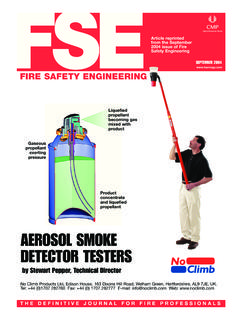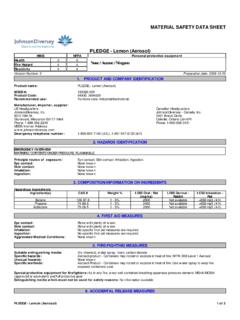Transcription of WD-40Aerosol-MSDS-Canada - aixsafety.com
1 WD-40 Page 1 of 4 MATERIAL SAFETY DATA SHEET SECTION 1 PRODUCT AND COMPANY IDENTIFICATION MANUFACTURER/SUPPLIER: WD-40 Products [ canada ] Ltd. Box 220 Toronto, Ontario M9C 4V3 Information Phone #: (416) 622-9881 Emergency Phone # 24 hr: Canutec: (613) 996-6666 Designated for use only in the event of chemical emergencies involving a spill, leak, fire exposure or accident involving chemicals PRODUCT NAME: WD-40 aerosol PRODUCT USE: Cleaner, lubricant. msds DATE OF PREPARATION: March 13, 2008 SECTION 2 HAZARDS IDENTIFICATION DANGER! Harmful of fatal if swallowed. Flammable aerosol . Contents under pressure. Avoid eye contact. Use with adequate ventilation. Keep away from heat, sparks and all other sources of ignition. POTENTIAL HEALTH EFFECTS: PRIMARY ROUTES OF ENTRY: Inhalation, skin and eye contact.
2 ACUTE EFFECTS: INGESTION: This product has low oral toxicity. Swallowing of the liquid contents may cause irritation, nausea, vomiting and diarrhea. The liquid contents are an aspiration hazard. If swallowed, can enter the lungs and may cause chemical pneumonitis. EYES: Contact may be mildly irritating to eyes. May cause redness and tearing. SKIN: Prolonged and/or repeated contact may produce mild irritation and defatting with possible dermatitis. INHALATION: High concentrations may cause nasal and respiratory irritation and central nervous system effects such as headache, dizziness and nausea. May aggravate existing respiratory conditions such as asthma. Intentional abuse may be harmful or fatal. CHRONIC EFFECTS: None expected. SECTION 3 COMPOSITION INFORMATION ON INGREDIENTS Ingredient CAS Number Percent Stoddard Solvent 8052-41-3 45-50% Petroleum Base Oil 64742-65-0 30-35% Non-Hazardous Ingredients Proprietary <10% Carbon Dioxide 124-38-9 2-3% SECTION 4 FIRST AID MEASURES For Medical Emergencies Call 1-888-324-7596 (24 hours/day) INGESTION: Aspiration Hazard.
3 DO NOT induce vomiting. Call physician, poison control center or the WD-40 Safety Hotline at 1-888-324-7596 immediately. EYE CONTACT: Flush thoroughly with water. Get medical attention if irritation persists. SKIN CONTACT: Wash with soap and water. If irritation develops and persists, get medical attention. INHALATION: If irritation is experienced, move to fresh air. Get medical attention if irritation or other symptoms develop and persist. WD-40 aerosol 03/13/08 Page 2 of 4 SECTION 5. fire FIGHTING MEASURES EXTINGUISHING MEDIA: Use water fog, dry chemical, carbon dioxide or foam. Do not use water jet or flooding amounts of water. Burning product will float on the surface and spread fire . SPECIAL fire FIGHTING PROCEDURES: Firefighters should always wear positive pressure self-contained breathing apparatus and full protective clothing.
4 Cool fire -exposed containers with water. Use shielding to protect against bursting containers. UNUSUAL fire /EXPLOSION HAZARDS: Contents under pressure. aerosol containers may burst under fire conditions. Vapors are heavier than air and may travel along surfaces to remote ignition sources and flash back. SECTION 6. ACCIDENTAL RELEASE MEASURES SPILL RESPONSE: Wear appropriate protective clothing (see Section 8). Eliminate all sources of ignition and ventilate area. Leaking cans should be placed in a plastic bag or open pail until the pressure has dissipated. Contain and collect liquid with an inert absorbent and place in a container for disposal. Clean spill area thoroughly. Report spills to authorities as required. SECTION 7. HANDLING AND STORAGE HANDLING: Avoid contact with eyes.
5 Avoid prolonged contact with skin. Avoid breathing vapors or aerosols. Use with adequate ventilation. Keep away from heat, sparks and open flames. Wash thoroughly with soap and water after handling. Do not puncture or incinerate containers. Keep can away from electrical current or battery terminals. Electrical arcing can cause burn-through (puncture) which may result in flash fire , causing serious injury. Keep out of the reach of children. STORAGE: Do not store above 120 F or in direct sunlight. (NFPA 30B) Level 3 aerosol . SECTION 8. EXPOSURE CONTROLE/PERSONAL PROTECTION OCCUPATIONAL EXPOSURE LIMITS: Stoddard Solvent 100 ppm TWA ACGIH TLV Petroleum Base Oil 5 mg/m3 TWA ACGIH TLV 10 mg/m3 STEL ACGIH TLV Non-Hazardous Ingredients None Established Carbon Dioxide 5000 ppm TWA, 30,000 ppm STEL ACGIH TLV The Following Controls are Recommended for Normal Consumer Use of this Product Engineering Controls: Use in a well-ventilated area.
6 Personal Protection: Eye Protection: Avoid eye contact. Safety glasses or goggles recommended. Skin Protection: Avoid prolonged skin contact. Chemical resistant gloves recommended for operations where skin contact is likely. Respiratory Protection: None needed for normal use with adequate ventilation. For Bulk Processing or Workplace Use the Following Controls are Recommended Engineering Controls: Use adequate general and local exhaust ventilation to maintain exposure levels below that occupational exposure limits. Personal Protection: Eye Protection: Safety goggles recommended where eye contact is possible. Skin Protection: Wear chemical resistant gloves. Respiratory Protection: None required if ventilation is adequate. If the occupational exposure limits are exceeded, wear a NIOSH approved respirator.
7 Respirator selection and use should be based on contaminant type, form and concentration. Follow applicable regulations and good Industrial Hygiene practice. Work/Hygiene Practices: Wash with soap and water after handling. WD-40 aerosol 03/13/08 Page 3 of 4 SECTION 9. PHYSICAL DATA APPEARANCE AND ODOR: Light amber liquid with a mild odor. Boiling Point: 300 F (minimum) Specific Gravity: @ 21 C Solubility in Water: Insoluble pH: Not Applicable Vapor Pressure: mmHg @ 20 F ( kPa) (stoddard solvent) Vapor Density: Greater than 1 Percent Volatile: 70% Flash Point: 43 C (TOC) Coefficient of Water/Oil Distribution: Not Determined Flammable Limits: LEL: UEL: Boiling Point: 323 F (minimum) aerosol Flame Extension: >45 cm Specific Gravity: 323 F (minimum) Flashback: None SECTION 10 STABILITY AND REACTIVITY STABILITY: Stable INCOMPATIBILITY: Strong oxidizing agents.
8 Avoid heat and open flames. Do not puncture or incinerate containers. HAZARDOUS DECOMPOSITION PRODUCTS: Carbon monoxide, carbon dioxide. SECTION11 TOXICOLOGICAL INFORMATION The oral toxicity of this product is estimated to be greater than 5,000 mg/kg based on an assessment of the ingredients. This product is not classified as toxic by established criteria. It is an aspiration hazard. None of the components of this product is listed as a carcinogen or suspected carcinogen or is considered a reproductive hazard. SECTION12 ECOLOGICAL INFORMATION No data is currently available. SECTION13 DISPOSAL CONSIDERATIONS WASTE DISPOSAL METHOD: If this product becomes a waste, it would be expected to meet the criteria of a hazardous waste based on flammability.
9 However, it is the responsibility of the generator to determine at the time of disposal the proper classification and method of disposal. Dispose in accordance with federal, state, and local regulations. SECTION14 TRANSPORT INFORMATION DOT Hazard Classification: Consumer Commodity, ORM-D Canadian TDG Classification: Limited Quantity IMDG Code Hazard Classification: UN1950, Aerosols, WD-40 aerosol 03/13/08 Page 4 of 4 SECTION15 REGULATORY INFORMATION FEDERAL REGULATIONS: CERCLA 103 Reportable Quantity: This product is not subject to CERCLA reporting requirements, however, oil spills are reportable to the National Response Center under the Clean Water Act and many states have more stringent release reporting requirements. Report spills as required under federal, state and local regulations.
10 SARA TITLE III: Hazard Category For Section 311/312: Acute Health, fire Hazard, Sudden Release of Pressure Section 313 Toxic Chemicals: This product contains the following chemicals subject to SARA Title III Section 313 Reporting requirements: None Section 302 Extremely Hazardous Substances (TPQ): None EPA Toxic Substances Control Act (TSCA) Status: All of the components of this product are listed on the TSCA inventory. CANADIAN REGULATIONS: Canadian Environmental Protection Act: All of the ingredients are listed on the Canadian Domestic Substances List or exempt from notification Canadian WHMIS Classification: Class B-5 (Flammable aerosol ). This msds has been prepared according to the criteria of the Controlled Products Regulation (CPR) and the msds contains all of the information required by the CPR.






